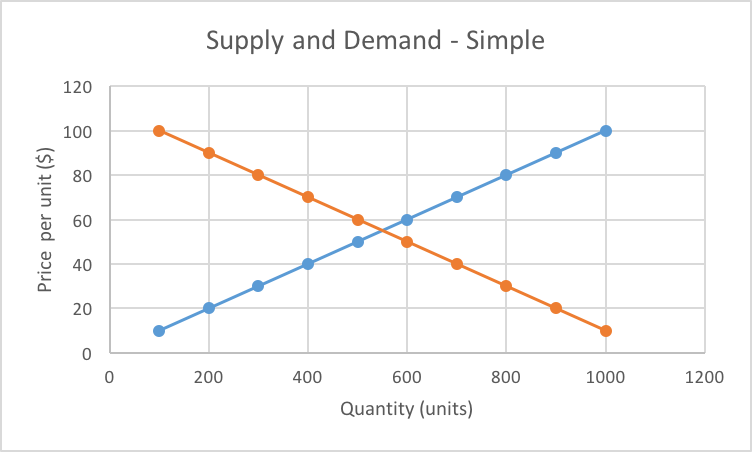Thermodynamic Expression of Economics
Supply and Demand
By Mark Ciotola
First published on May 17, 2019. Last updated on May 31, 2025.
Introduction
Supply and Demand theory models at which prices consumers will purchase a product, at what prices will producers sell a product, and the resulting market price for the product. Supply and demand provides a framework for understanding pricing and sales volume. Although real life pricing sometimes deviates from this idealized theory, the Supply and Demand approach can help identify why those deviations exist.
Supply Function
The supply function is the price at which producers will sell a product as a function of quantity sold. According to theory, producers will demand a higher price for each additional unit of product sold, due to increasing marginal costs. Let’s use gold as an example. Each additional unit of gold mined requires gold producers to mine more deeply into the ground (or use lower grade ore), which is more expensive. In summary, suppliers tend to charge more money per additional unit supplied, at least in the short run.
Demand Function
The demand function is the price at which consumers will buy a product as a function of quantity purchased. According to theory, consumers will only pay a lower price for each additional unit of product purchased, due to a decreasing marginal utility. (Utility means the value the the product to consumers). Continuing with gold for an example, consumers only really need a small amount of gold. They might be willing to pay all their savings for gold engagement jewelry. They might still be willing to pay a lot of money per gram for additional gold jewelry. Beyond that, most people do not have a high need or strong desire for more gold, and would not be willing to pay as much for more of it.
Determining the Market Price
These functions can be plotted, with the axes being price and quantity. Where these two functions intersect indicates both market price and quantity produced. The plots shown are examples. Actual plots may vary.

Market price and quantity are where supply and demand functions meet to determine market price.
The rising plot represents the Supply Function. The falling plot represents the Demand function. Where they meet is the price at which the supplier (seller) and “demander” (buyer or customer) agree to conduct the transaction. Where they meet also shows the quantity of goods or services transferred.
« Fourier’s Law of Heat Conduction | COURSE | Expressing Supply and Demand Thermodynamically »